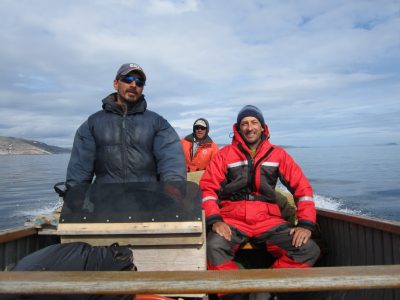Carleton PhD Biology student Samuel Iverson, along with Prof. Mark Forbes and Adjunct Prof. Grant Gilchrist have found that there has been a large increase in polar bear visits to bird colonies in the eastern Canadian Arctic due to shrinking sea ice. The increase is impacting bird populations and the safety of researchers.
A paper outlining the change in menu was published on Feb. 5. It is co-authored with Paul Smith and Anthony Gaston from Environment Canada, with help from Inuit residents.
“Our research shows a seven-fold increase in bear incursions at one nesting site that has been monitored since 1997 and an eight-fold increase at another monitored since 1988,” says Iverson. “At the first site, the increased presence of bears has caused near total reproductive failure in recent years.”
He continues: “The bears use sea ice as a platform to hunt for the seals which is their favourite food. But when the ice melts, they go looking for anything they can find, and often resort to eating bird eggs.”
He points out that the Northern Common Eider population is especially vulnerable because these ducks lay three to four large eggs in nests on the ground where the bears can easily find them.
Adds Iverson: “The bears press their noses against the eggs, breaking the shell, and then eat the inside contents.”
“Bears are arriving at these colonies in response to climate change and shrinking ice,” says Gilchrist. “The birds aren’t used to this new threat and in many cases it is proving to be devastating. The increase in bear numbers has been so great that to protect our research crew we have had to shorten our field season. When you are on an island that is 800 metres long with three bears, you are camping with them.”
The paper, entitled Longer ice-free seasons increase the risk of nest depredation by polar bears for colonial breeding birds in the Canadian Arctic, is among the first to link climate change with predator-prey relationships. It reveals that polar bears are affected by the loss of sea ice, which limits access to their preferred prey – seals.
It appeared in the journal Proceedings of the Royal Society B: Biological Sciences.
Given less opportunity to hunt for seals, bears are turning to alternative prey to offset nutritional shortfalls. Eggs of colonial nesting birds are one such alternative prey item. Bears have long been known to eat them, but the paper concludes that the behaviour is on the rise.
The authors worked closely with Inuit in seven communities to examine the geographic extent of the issue. Inuit harvesters initially identified the issue as an economic concern as it reduces their ability to collect down from nesting birds.
The paper also relied on long-term data collected by the Canadian Ice Service that shows a dramatic decrease in the length of winter ice seasons due to warmer Arctic temperatures.

Wednesday, February 5, 2014 in Grad Student Research, News
Share: Twitter, Facebook




